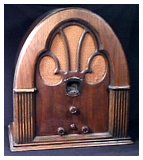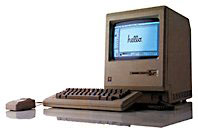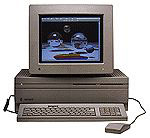- 2001.09.07
One of my hobbies, aside from working with Macintosh computers,
is collecting antique radios. I have realized that both of my
interests have several things in common with the other. Both
Macintosh computers and antique radios both feature some
interesting designs.
During the 1930s, the many designers (such as Raymond Loewy,
Henry Dreyfuss, Walter Dorwin Teague, and Norman Bel Geddes)
restyled common products in order to try to help them sell better
in the poor economy. It wasn't just radios that started showing up
with new designs, but toasters, refrigerators, and telephones,
among other things. New materials were also being used, such as
Bakelite ("the material of a thousand uses"), Catalin, and
Plaskon.
The key phrase was "a radio in every room" - and radio
manufacturers hired famous designers to come up with new cabinet
designs so that people would buy their products. One of the most
popular designs is known as "Art Deco," which came around after the
1925 Paris Exhibition.
New ideas started becoming popular, like the clock radio. Have
one in your bedroom to wake up  to and another
in the kitchen, which featured an electric outlet in the back for
your coffee machine, to make your coffee in the morning.
to and another
in the kitchen, which featured an electric outlet in the back for
your coffee machine, to make your coffee in the morning.
Some radios had their cabinets designed to help the radio
function better. The Stewart Warner model R 1821A has the speaker
on the left side, facing inwards, for better sound. The Philco
model 16L floor model has a special rear cover over the speaker
portion of the cabinet, to help improve the already excellent
sound. From built-in antennas that you could rotate to improve
reception to "magic eye" tubes which helped you tune in a station
better, there were all sorts of new gimmicks to make people want to
buy a specific model of radio.
Take a look at Apple computers. Each case has been designed to
look nice as well as function with the hardware design. The Quadra
700 was designed so that it draws air in through the floppy drive
slot. The iMac is designed with special vent holes so that the
system is kept cool without a fan. The AppleDesign team has come
up with some truly unique designs,  such as the original Macintosh case design, the
Colour Classic, and the 20th Anniversary Macintosh. Each new model has
some new feature which you "can't live without" (the handle on the
original iBook, the slot loading CD-ROM drive on the iMacs).
such as the original Macintosh case design, the
Colour Classic, and the 20th Anniversary Macintosh. Each new model has
some new feature which you "can't live without" (the handle on the
original iBook, the slot loading CD-ROM drive on the iMacs).
While Macintosh computers weren't always designed by famous
designers, there is a lot of thought that goes into the design. The
lines on the Macintosh II aren't there
for no reason. Try to picture a Mac II without the lines on the
top, side, and bottom of the front.  It would be
pretty plain, boring, and unprofessional looking. Adding some
simple lines really improved the look of the machine.
It would be
pretty plain, boring, and unprofessional looking. Adding some
simple lines really improved the look of the machine.
If the iMac had shipped in beige
instead of Bondi blue, chances are that it wouldn't have sold as
well.
The design of the Mac is one reason why they always manage to
look good - even old models. The Quadra 630 (1995) looks just as modern as
the beige G3 desktop (1997).
Antique radios always look good, also because of their design.
While the components inside are not made with the latest
technology, the design of the case can look great even in the most
modern of rooms.
I will be mentioning several "further reading" links next week
regarding design in the 1930s. In the meantime, if you are
interested in looking for an antique radio, there are a couple
places you can look. eBay
can be a great place to buy them, but you really have to know what
you are buying, and it is almost impossible to get a guarantee that
a radio is working even if the seller says it is. The electronics
are over 50 years old.
If you just want one to put up on a shelf to look at, eBay might
be the best way to go. If you want a working radio with a
guarantee, I suggest you contact someone who restores these radios,
such as Mike Urban at Urban Radio
& Collectibles.
More soon.

 to and another
in the kitchen, which featured an electric outlet in the back for
your coffee machine, to make your coffee in the morning.
to and another
in the kitchen, which featured an electric outlet in the back for
your coffee machine, to make your coffee in the morning. such as
such as  It would be
pretty plain, boring, and unprofessional looking. Adding some
simple lines really improved the look of the machine.
It would be
pretty plain, boring, and unprofessional looking. Adding some
simple lines really improved the look of the machine.
